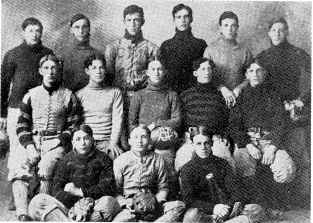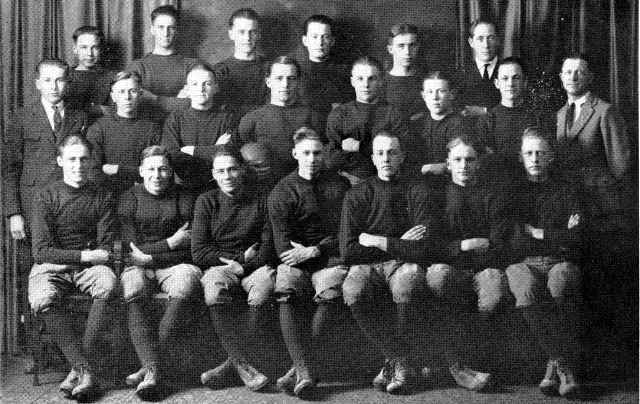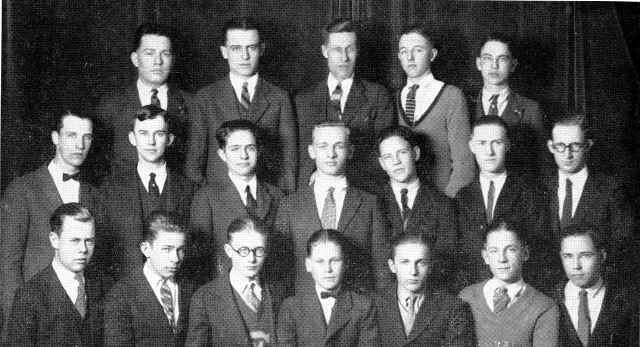NEGenWeb Project
Resource Center
On-Line Library
|
| 550 |
The History of Platte County Nebraska |
growth in keeping with the city which
saw its first primitive telephone communication system established at the Columbus
depot in 1878 -- a growth measured in efficiency, speed and lowered costs to
the users of the system.
From the time, in 1883, when the Columbus Athletic Association was formed "to construct and maintain suitable grounds, buildings and the like for the holding and encouraging of games of baseball and all other athletics," Columbus has kept pace with the rest of America where its interest in spectator and active sports is concerned.
The Evans Rifle Club was organized about 1900. The Columbus Driving Club, which specialized in the training, racing and exhibition of horses, existed before the turn of the century and again from 1907 to 1910. A modern race track was built in 1941, at the Agricultural Park where annual summer race meets- are conducted by the Racing Committee. Columbus Baseball Clubs, Kramer High School and St. Bonaventure's football and basketball teams, all have engaged the enthusiastic support of the people.

The Columbus Football Team of 1905. Top row, left to right: Howard McCray, Horatio Adams, Ira Betterton, Jesse Betterton, Donald McAllister, Fred Baker. Center row: John Neater, Myron Gray, John Elliott, Joe McCloud, Vernon Erskine. Bottom row: Christie Gass, Langford Beecroft, William Hockenberger. |
In the early years, 1905 was a record high school football year in Columbus, when the following Columbus men played on the high school team: Howard McCray, Horatio Adams, Ira Betterton, Jesse Betterton, Donald McAllister, Fred Baker, John Neater, Myron Gray, John Elliot, Joe McCloud, Vernon Erskine, Christie Gass, Langford Beecroft and William Hockenberger. Like the baseball club, this team engaged in games with other nearby Nebraska high school teams.
Today Columbus goes
for its softball games to the field in Pawnee Park; football, a favorite high
school sport, is one of the highlights of the autumn season and a winning team,
like an Olympian victory in ancient Greece, is celebrated by all the inhabitants
of the town.
The county also has its serious side. Platte County measures its current resources in terms of millions of dollars. Hundreds of prosperous homes, well-developed villages and towns, paved streets, highways, railroads, bus and trucking lines and all the accoutrements of modern civilization have made this region wealthy far beyond the dream of its most idealistic pioneers.
Out of the natural resources of productive soil, sunshine, rain, and a growing climate, the first settlers wrought a beginning. They invested their savings in plows, harrows, machinery and the commercial and manufacturing enterprises. Mutual obligation and mutual respect grew up between the town, Columbus, and Platte County; and, in its turn, the relationship of the county to the overall state was placed on a strong footing. Modern surveyors and analysts are mindful of the prompt distribution of commodities and the excellence of educational, religious, medical and recreational facilities which sets Columbus apart as a community with a future as well as a past.
Much credit for this spectacular growth goes to the Chamber of Commerce which is in the vanguard of every move to increase the prestige of the town. The Chamber came into existence around 1908, under the name of the Commercial Club. One important facet of its program centered around the establishment of modern roads under the slogan, "Take Nebraska Out of the Mud!" A. R. Miller of Columbus was one of the ardent supporters of the latter move and the group worked in cooperation with the Nebraska Good Roads Association and the Lincoln Highway Association.
The State Young Men's Christian Association summer camp was another plank in the Commercial Club's platform and the organization continued to support local measures of this type until it made the transition into its present state in 1934, when word was first received of the allotment of six million dollars for the construction of the power canal in Platte County.
Two years earlier this same group of men had raised ten thousand dollars for a fund to be used to finance the preliminary stages of the power project before it could be considered by the federal government. Many others also contributed but the fund, as a whole, came about as a result of the effort of this commercial group. A new secretary was employed in 1934 and plans un-

The Columbus football team of 1924-25. Top row, left to right: Roy Galley, Edmund Bakey, Charles Gass, Henry Ragatz, Ill, I. Jaeger, and Elmer Brock. Second row: Leonard Miller, Ernst, Lester Poesch, Arnold Oehlrich, Charles Miller, Bert Bosserman, Milton Pittman, and James Rich. Bottom row: Art Haney, L. Wotke, Lohr, Julius Hembd, Thomas Jaworski, Clark Burgess, and Jack Putman.
dertaken for a live civic program. Membership increased from one hundred to three hundred fifty and the budget was correspondingly raised from thirty-five hundred dollars to eight thousand, nine hundred dollars.
Parking, housing and convention visitations became a part of the Chamber agenda. Good will tours were taken to neighboring communities. A manufacturers' bureau functions actively and farmers' "short courses" are given regularly by the Agricultural Committee. Retail selling courses also are presented by the Education Committee through the cooperation of the Columbus Public Schools and the Vocational Education Department of the State of Nebraska. A Junior Chamber of Commerce adds its weight to the participation of mercantile and business leaders in local politics and much of the activity of these groups centers around the intelligent planning of community facilities.
With a long record of genuine service to Columbus and Platte County, the Chamber of Commerce looks back to the early promotional days of the Black Hills Mining Company and other ventures for its inspiration. To its work the group brings the advantages, of modern techniques which make public relations into a science.
"In substance," wrote an early Platte County booster in 1886, "there is only one proper way to run a town. This is to make everything count toward the general welfare; let enterprise, public and private, be the watchword, and let us make the most of our circumstances." This has been the theory followed by the officers of the Chamber of Commerce in Columbus. The 1947 officers were: Howard Burdick, president; Noyes C. Rogers, first vice president; Leonard Miller, second vice president; P. L. Bauer, third vice president; John Armstrong, treasurer. Serving on the board of directors were: Wilbur W. Johnson, Charles M. Ball and Walter Behlen. In 1948, Elmer Lohr was the president and in 1949, H. P. Behlen was elected to that office.
1947 officers of the junior Chamber of Commerce, also referred to as the "Jaycee," included: Vincent Jones, president; Robert Lofton, vice president; and Harvey Loseke, secretary. Offices for both groups are maintained in the City Hall and new officers are elected annually. In 1948 the president was Harold Ward and the 1949 president was Harvey Loseke.
|
| 552 |
The History of Platte County Nebraska |

The Hi-Y Club of Columbus, 1924-1925. Top row, left to right: Henry Ragatz, Ill, Charles Gass, Mr. Wise, secretary of the Y.M.C.A., Marshall Geer, and Wallace Ott. Center row: Fred Biggs, Christian Allenburger, Edgar Backus, Ronald Anderson, Con Keating, Gayle Boyd, and Charles Sheldon. Bottom row: Carroll Miller, Crawford Snell, Walter Gregorius, Joy Brown, Gerhardt Koch, Robb Lecron, and Roy Galley.
Even in the most modern citadels of civic development, however, there remain evidences of early culture. Once primitive people owned the soil that now supports many thousands of Columbus residents in an elaborate system of economic interchange. Pawnee Park, sometimes called the "Picnic Grounds of Mid-Nebraska," was a wide area along the north bank of the Loup in the days of Columbus' founding. Contemporary pleasure-seekers are still finding pieces of pottery, arrow tips and other relies buried in the ground.
The original acquisition of the preserve along the Loup was 83.67 acres. A small strip was added later and in 1935, a thirty-acre plot east of United States Highway 30 was bought, bringing the total area of Pawnee Park to one hundred twenty-five acres. Under the sponsorship of the Columbus Fire Department and the Junior Chamber of Commerce, a bond election was held which made possible the construction of a swimming pool and later, the first softball field, complete with night lighting and other facilities, was added.
Large crowds of picnickers annually visit the park and many journey out to the park for football, baseball and softball programs where a large stadium and modern sports arena was dedicated May 30, 1948.
Once used as a hitching and feeding spot for horses, Frankfort Square at one time was the tethering place for as many as one hundred teams on busy shopping days. Ox teams then grazed in the lot at the corner of Twenty-seventh Avenue and Fourteenth Street, where the Federated Church now stands, and Gottschalk's pasture, was the scene of the pioneer Columbus golf course.
All of the parks are now incorporated in the city's modern park system, administered by a board of park commissioners appointed by the mayor. The 1948 officers serving in that capacity included: Doctor C. V. Campbell, chairman; Jacob Glur, Frank Tooley and William L. Boettcher. Harvey Loseke succeeded A. W. Frischholz as secretary to the park board and R. A. Stoll serves as park superintendent.
Another adjunct to the park system was Buffalo Square, used for public gatherings in the early days, and Hanover Square which serves as a playground for Columbus' youthful population, and for a brief period returned veterans and their families were housed there. In Highland Park, in the west part of town, Fountain Square was dedicated as a park when the Highland Park Addition was added to the city.
Many men have contributed to the outstanding park system now in operation in Columbus.
In addition to the work of such organizations as the fire department and the American Legion, history records the fact that John Rickly first donated the ground for Frankfort Square while Clarence Gerrard contributed generously to Pawnee Park. Before a park board was established, a group of city councilmen worked hard to provide this necessary recreational outlet for the growing community and previous superintendents of the park system were Carl Harms and Leonard Briggs.
Amusement facilities have always been wholesome and abundant in Columbus. The 1876 townfolk had their Music Hall Association and the early opera and Chautauqua provided entertainment for many. From all over the eastern half of Nebraska pleasure-boaters in the years 1937-1942, sailed their crafts on the waters of Lake Babcock and during that period, motor boats and sail boats were both exceedingly popular on the lake. One kayak canoe was launched and an average of three hundred to three hundred fifty cars visited the area each Sunday until around 1945. Boat owners who took advantage of the lake, included: H. D. Ross, William Kneifel, L. Francis Shank, Doctor David T. Martyn, William Kaufman, William Markhofer, Alex Gottberg, Theodore Kaufman, Elmer Bartels and Leonard Miller of Columbus; Frederic Harris of Monroe and Kenneth Maurer and Sawyer Abbott of Genoa; M. M. Andrews of Lindsay; Jerry S. Prokes of Schuyler; Doctor Darrell E. Trump of Utica and Doctor E. A. Rogers of Madison. These are but a few of the many visitors to the sand beach on the north shore of Lake Babcock where police service was maintained by the Loup district for the protection of pleasure seekers.
For a while, during the 1920's, chess was revived by the Elks' Club of Columbus and enjoyed a community following. Religious festivals have remained consistently popular. Many of the nationality groups prior to 1917 held celebrations on the holidays which marked the important events of their native lands. Among the Polish settlements, the custom of elaborate three-day marriage festivals has given way to more modern observances, but a large portion of the social life of every Platte County community still revolves around the church in the form of bazaars, suppers, and other social gatherings.
Shades of the past
are evoked by the recollection of the early theatrical offerings of the twentieth
century when "Vernon the Great" was one of the leading headliners,
assisted by his "Big Hypnotic Comedy Company." The
old opera house and the North Theatre were much in use in those days when "soul
stirring plays," and "terse, epigrammatic" lectures
played to the Nebraska and mid-western circuits as a regular feature. Later
years saw the standardization brought about by motion pictures and other entertainment
forms which put Columbus on a par with other communities, both large and small,
throughout the United States.
As Columbus grew, the civic props which maintained it took on additional responsibility and one of the most outstanding of these groups was the Columbus Fire Department. Prevention has constituted an all-important activity of the department in recent years with the result that Columbus has maintained an excellent record for fire loss.
Equipment provided by the city for the department included: A Seagrave seven hundred fifty-gallon pumper with a one hundred-gallon booster tank; a Seagrave air-cooled combination chemical and hose truck; a Seagrave hook and ladder truck and a Republic hose truck, four thousand feet of hose and salvage covers. The First Aid Department includes a lung-motor, and Seagrave pumper and ladder truck, added in October, 1936. Since that time modern equipment has been added annually.
Outdoor practice in fire fighting during the summer months is supplemented by blackboard sessions in the winter. The Columbus Fire Department also devotes much time to social activities and civic enterprises; annual smokers and a yearly dance are notable among department-sponsored events. In addition, firemen have equipped their own club rooms, financed two city hail elections and donated to other organizations whose programs merited aid.
One touch of human
interest in the story of contemporary Columbus is the 1906 item which announced
the arrival of that great American institution -- the ice cream cone, in town:
William Poesch was the enterprising merchant who introduced the modernization,
and the Telegram story reported it as follows:
"William Poesch has added to the equipment of his ice cream factory a cone machine, by which he will be enabled to enclose in pastry cones a sufficient quantity of ice cream for one person. This is said to be a favorite method of serving ice cream in the cities, and Mr. Poesch thinks there is nothing too good for Columbus."
Later years have seen the proof of the statement that there "is nothing too good for Colum-
|
|
|
|
|
© 2005 for the NEGenWeb Project by Ted & Carole Miller
|






